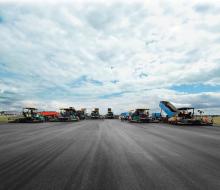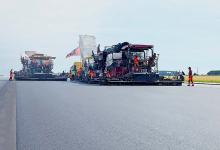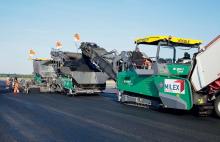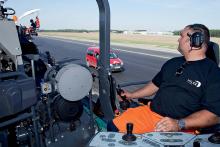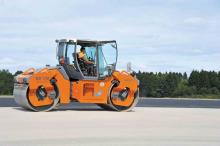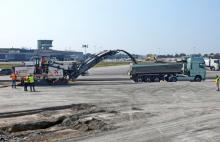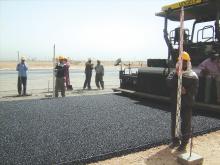Airport runway, taxiway and parking areas make high demands on paving requirements, both with concrete and asphalt techniques. Mike Woof reports. High quality surface finishes are required in airport environments for runways, taxiways and aircraft parking areas. Because of the speed at which aircraft take off and land and the massive forces exerted due to the weight of the aircraft, particularly during landing, runway structures need to be incredibly strong. The surfaces also have to be constructed to very

Using a material transfer vehicle in an airport paving application is particularly useful as this minimises material segregation and ensures a steady flow of asphalt to the paver.
RSS
The highs and lows of the temperature scale can cause particular issues in an airport environment for the runway surface, which simultaneously has to deal with the heaviest shock loadings when pounded by aircraft on landing and during braking. Canadian firm Heat Design Equipment says that its infra-red asphalt heating machines offer a suitable solution for preventing early failure of longitudinal construction joints. These joints occur when a strip or lane of hot mix asphalt (HMA) is constructed next to previously placed HMA and can often become the weakest part of a multilane pavement structure, causing failure of an otherwise good pavement. For airport runway and apron sections paved with asphalt, joint failure can constitute a major problem and proper placement of HMA is critical to performance.
There are numerous technical factors to be taken into account and unlike highways, airport pavements experience lower load repetitions but with higher loads. In highway applications there is a kneading effect from the traffic that can improve joint interfaces, although the lower level of traffic in an airport environment means that there is no such benefit to the joint in this type of application.
Placing a new HMA strip adjacent to an existing one presents a challenge and site practice often results in joint densities that are significantly lower than those in the mat. With the conventional process, the first compaction pass pushes material out against an unconfined edge, leaving reduced density. This means that for the second pass, proper compaction can be impacted by cooling HMA. The cold lane has lower density and cools faster, which will often result in ravelling occurring on the cold side after a period of time. With distress extent and propagation, the crack expands, water enters the joint, and the freeze thaw action destroys the pavement edge. The challenge with joint failures is that they need constant attention and if neglected, will result in more serious problems.
Although there are some techniques designed to prevent such early joint failure, Heat Design Equipment says that infra red heating technology provides the most reliable solution. According to a trial carried out in the US state of New Hampshire, 93% of the traditional joint treatments for test sections failed whereas only 17% failed where infrared heating had been used.
Echelon paving can be carried out on some sites and this is particularly effective where material transfer equipment is used to ensure a constant supply of unsegregated mix into the two pavers working in tandem. However, this is not always practical and for airport applications, using infra red heating to ensure effective joints between hot and cold mats can offer major gains in the life of runways, taxiways and aircraft parking areas, as well as reducing maintenance costs and boosting safety.
Heat design Equipment proved the effectiveness of its infra red machines on a project for a new Heliport for Canada's Department of National Defense. Located in Nova Scotia, the facility was being upgraded to handle military helicopters and all the operational surfaces were paved with asphalt that consisted of an 80mm base course and a 40mm surface course. The work required some 18,000 tonnes of material laid over a 1.08km length by 34.2m wide, with tight tolerances for both the base and surface course. The specification said that cold longitudinal joints had to be avoided or minimised, so the contractor suggested using the infra red equipment. A trial was carried out and Heat Design's 400P model was used to raise the temperature of the joints, with the heater being towed by a small tractor. The results proved a success and the client specified that the infra red equipment should be used on the paved joints for Phase II of the upgrade work at the helicopter facility as a result.
Before new asphalt is laid when repairing an existing asphalt runway or taxiway surface, milling is often carried out first and high productivity and accuracy are required. In addition, any milled areas have to be carefully cleaned before aircraft can use these areas, as debris could cause costly damage to tyres and engines and poses a potential safety hazard.
Indian178 Caterpillar dealer 1144 Gmmco recently supplied a second Cat cold planer, a new PM200 to contractor 1145 Ashwini Infra Developments. This is the first PM200 supplied to India and has been used by the contractor on a contract to mill and pave a runway at the Chhatrapati Shivaji International Airport in Mumbai. This is India's largest airport and the runways required upgrading to international standards in order to handle the larger Airbus A380s.
The contractor used the Cat PM200 alongside its existing PM102 for the milling work to meet the stringent time requirements. The new machine has proven reliable and productive so far and work to upgrade Mumbai airport continues at present. The work being carried out is extensive and in its first two months, over 78,000m2 of asphalt was removed.
To cope with larger and heavier aircraft and increased numbers of flights, Akureyri Airport in Iceland had to be upgraded by lengthening and strengthening its runway. Icelandic contractor Hladbaer-Colas rehabilitated the old runway and one of the first tasks was to tackle the undulating surface irregularities that had developed over the years. Height differences of as much as 200mm had to be levelled out in the course of the rehabilitation work. Hladbaer-Colas decided to use a1194 Vögele paver fitted with the NAVITRONIC Plus system for 3D machine control to achieve the tight surface tolerances required.
Before the paver was put to work, a compact2395 Wirtgen W350 milling machine was used to remove half of the 200mm of surface undulations. The paving team then placed a 100mm level regulating layer with a Vögele SUPER 1800-2 paver that was fitted with an AB500-2TV Extending Screed. The level regulating layer was followed by wearing course placed in widths of 4-5m. Paving in varying width was carried out to avoid creating longitudinal joints right above those of the level regulating layer. The aggregate contained in this mix was an imported Norwegian granite, which due to its hardness is particularly strong and long-lasting as the rock volcanic Iceland is porous nature and is not suited for asphalt paving. Altogether, the Hladbaer-Colas team placed nine strips, always working from the outside in. Each of the 2,000m strips had to be completed in just one day so that the runway could be used for air traffic the following morning.
The tight tolerances on surface smoothness and evenness were achieved, due to the use of the sophisticated Vögele paving control system, which was combined with an SBG external computer and tachymeters from265 Leica. Using this set up eliminated the need to install reference wires, reducing the time needed to carry out the paving job and allowing the contractor to meet a tight time schedule, while also providing high accuracy. All told, at least 18km of reference wire would have been required using conventional methods at an estimated cost of some €50,000.
The overall width of the runway and landing strip at Akureyri Airport is 45m. Added to this are hard shoulders, 7.5m wide on each side, giving a total width of 60m. The SUPER 1800-2 paved wearing course in a thickness of 50mm. After completion, two 8tonne class DV70VO tandem rollers equipped with oscillation technology from sister firm228 Hamm were used to compact the asphalt. And once the work had been carried out, tests showed that the pavement profile specified in the longitudinal and the transverse direction also met the high accuracy requirements.RSS
Airport runway, taxiway and parking areas make high demands on paving requirements, both with concrete and asphalt techniques. Mike Woof reports.
High quality surface finishes are required in airport environments for runways, taxiways and aircraft parking areas. Because of the speed at which aircraft take off and land and the massive forces exerted due to the weight of the aircraft, particularly during landing, runway structures need to be incredibly strong. The surfaces also have to be constructed to very tight tolerance requirements, providing sufficient skid resistance properties to allow safe braking from speed and being smooth enough to prevent damage to aircraft undercarriages. Because of the speeds involved, the quality of a runway surface has major safety implications. Poor quality surfaces cannot be tolerated in such an environment and any poor results achieved during construction have to be corrected quickly, to maximise safety as well as to minimise the risk of damage to extremely costly aircraft. Both asphalt and concrete construction techniques are used in airports and these have separate benefits for certain applications.The highs and lows of the temperature scale can cause particular issues in an airport environment for the runway surface, which simultaneously has to deal with the heaviest shock loadings when pounded by aircraft on landing and during braking. Canadian firm Heat Design Equipment says that its infra-red asphalt heating machines offer a suitable solution for preventing early failure of longitudinal construction joints. These joints occur when a strip or lane of hot mix asphalt (HMA) is constructed next to previously placed HMA and can often become the weakest part of a multilane pavement structure, causing failure of an otherwise good pavement. For airport runway and apron sections paved with asphalt, joint failure can constitute a major problem and proper placement of HMA is critical to performance.
There are numerous technical factors to be taken into account and unlike highways, airport pavements experience lower load repetitions but with higher loads. In highway applications there is a kneading effect from the traffic that can improve joint interfaces, although the lower level of traffic in an airport environment means that there is no such benefit to the joint in this type of application.
Placing a new HMA strip adjacent to an existing one presents a challenge and site practice often results in joint densities that are significantly lower than those in the mat. With the conventional process, the first compaction pass pushes material out against an unconfined edge, leaving reduced density. This means that for the second pass, proper compaction can be impacted by cooling HMA. The cold lane has lower density and cools faster, which will often result in ravelling occurring on the cold side after a period of time. With distress extent and propagation, the crack expands, water enters the joint, and the freeze thaw action destroys the pavement edge. The challenge with joint failures is that they need constant attention and if neglected, will result in more serious problems.
Although there are some techniques designed to prevent such early joint failure, Heat Design Equipment says that infra red heating technology provides the most reliable solution. According to a trial carried out in the US state of New Hampshire, 93% of the traditional joint treatments for test sections failed whereas only 17% failed where infrared heating had been used.
Echelon paving can be carried out on some sites and this is particularly effective where material transfer equipment is used to ensure a constant supply of unsegregated mix into the two pavers working in tandem. However, this is not always practical and for airport applications, using infra red heating to ensure effective joints between hot and cold mats can offer major gains in the life of runways, taxiways and aircraft parking areas, as well as reducing maintenance costs and boosting safety.
Heat design Equipment proved the effectiveness of its infra red machines on a project for a new Heliport for Canada's Department of National Defense. Located in Nova Scotia, the facility was being upgraded to handle military helicopters and all the operational surfaces were paved with asphalt that consisted of an 80mm base course and a 40mm surface course. The work required some 18,000 tonnes of material laid over a 1.08km length by 34.2m wide, with tight tolerances for both the base and surface course. The specification said that cold longitudinal joints had to be avoided or minimised, so the contractor suggested using the infra red equipment. A trial was carried out and Heat Design's 400P model was used to raise the temperature of the joints, with the heater being towed by a small tractor. The results proved a success and the client specified that the infra red equipment should be used on the paved joints for Phase II of the upgrade work at the helicopter facility as a result.
Before new asphalt is laid when repairing an existing asphalt runway or taxiway surface, milling is often carried out first and high productivity and accuracy are required. In addition, any milled areas have to be carefully cleaned before aircraft can use these areas, as debris could cause costly damage to tyres and engines and poses a potential safety hazard.
Indian
The contractor used the Cat PM200 alongside its existing PM102 for the milling work to meet the stringent time requirements. The new machine has proven reliable and productive so far and work to upgrade Mumbai airport continues at present. The work being carried out is extensive and in its first two months, over 78,000m2 of asphalt was removed.
To cope with larger and heavier aircraft and increased numbers of flights, Akureyri Airport in Iceland had to be upgraded by lengthening and strengthening its runway. Icelandic contractor Hladbaer-Colas rehabilitated the old runway and one of the first tasks was to tackle the undulating surface irregularities that had developed over the years. Height differences of as much as 200mm had to be levelled out in the course of the rehabilitation work. Hladbaer-Colas decided to use a
Before the paver was put to work, a compact
The tight tolerances on surface smoothness and evenness were achieved, due to the use of the sophisticated Vögele paving control system, which was combined with an SBG external computer and tachymeters from
The overall width of the runway and landing strip at Akureyri Airport is 45m. Added to this are hard shoulders, 7.5m wide on each side, giving a total width of 60m. The SUPER 1800-2 paved wearing course in a thickness of 50mm. After completion, two 8tonne class DV70VO tandem rollers equipped with oscillation technology from sister firm

